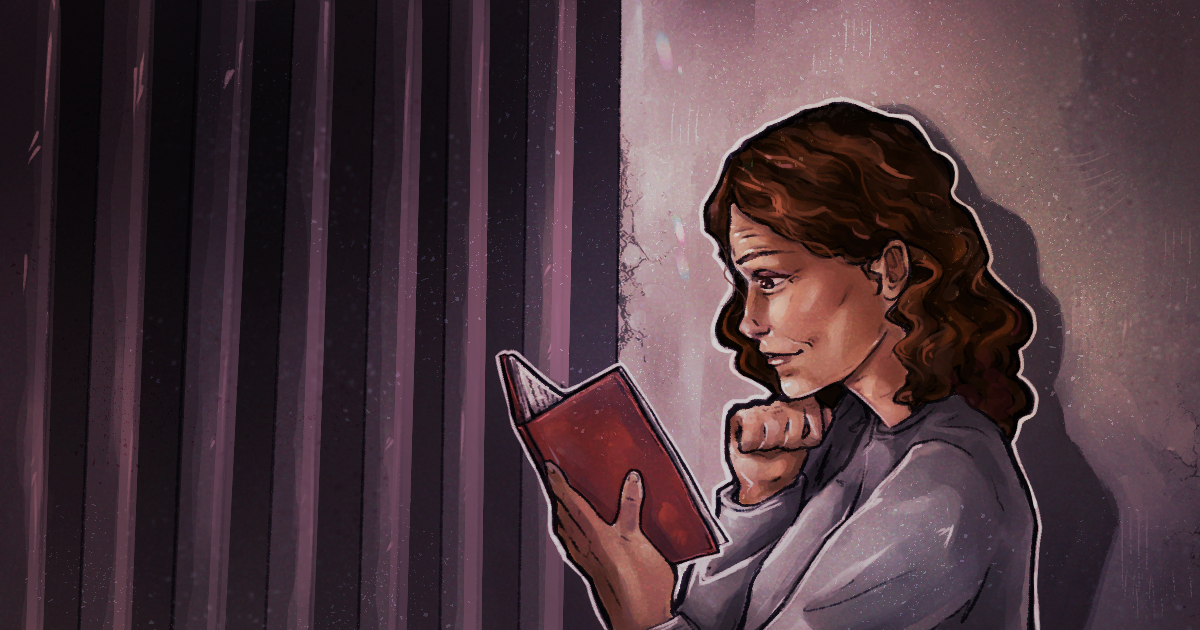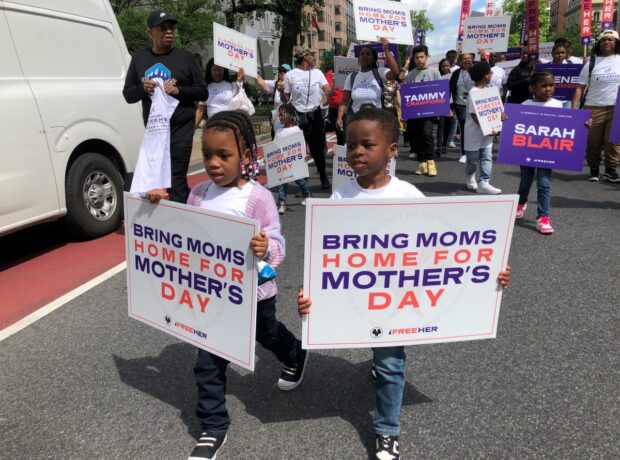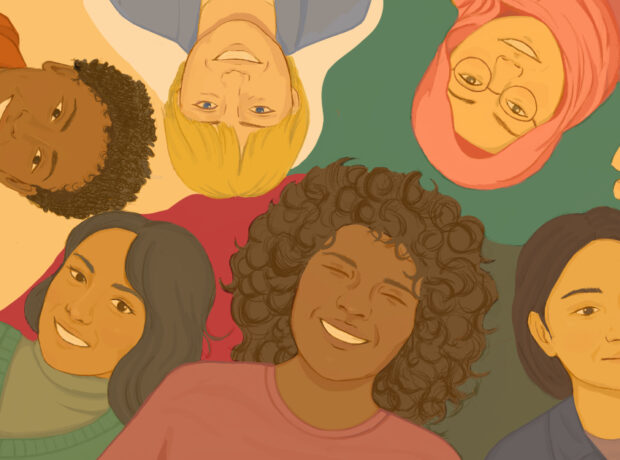This story gives a fascinating insight into life in a women’s prison through the eyes of a writing teacher and her students – the inmates. Questioning the purpose of the prison’s “Do-Not-Read” list of banned books, and exploring the complex histories of her students, the author reminds us of the transformative power of reading and writing.
I’m teaching English literature and composition on a remote campus at an undisclosed location in the Southern US.
My assigned classroom is a computer lab with just enough floor space to corral 16 rolling chairs into a cozy circle. A narrow window looks out on a small lake where the black-winged darters come to fish.
My students file in dressed in shapeless blue cotton. They range in age from mid-twenties to mid-sixties. I ask each one to introduce herself and choose a pseudonym.
Why the secrecy? My students reside in a high-security state women’s prison. They are taking this course to read literature by and about people who are incarcerated and to explore ways to tell their personal stories.
I try to keep a low profile because the Department of Corrections (DOC) is not keen on the residents learning about prisons or reporting what goes on inside the compound.
The correctional officers are courteous, but their black leather boots and belts, their cannisters and keys, and their barked commands, make me nervous.
I start the class with a writing exercise and I’m immediately impressed and delighted with how eager these students are to tell their stories. They write about good times and bad times. They already know how to capture an audience.
Their tales are full of colorful characters and vivid scenes: a father who wore his toupée to bed, a little sister who got clobbered by a swarm of bees, the remembered taste of maple syrup poured over a bowl of snow.
This class is the second in a series. The first semester focused on novels, the second on memoirs. The readings are meant to foster dialogue through an exchange of letters between “insiders,” women in prison, and “outsiders,” college students in another state.
The women are excited to get letters from beyond the barbed wire. The college students are curious to find out how criminal justice policies affect real people in real time. The use of pennames (which are also used in this article), allow them to remain anonymous.
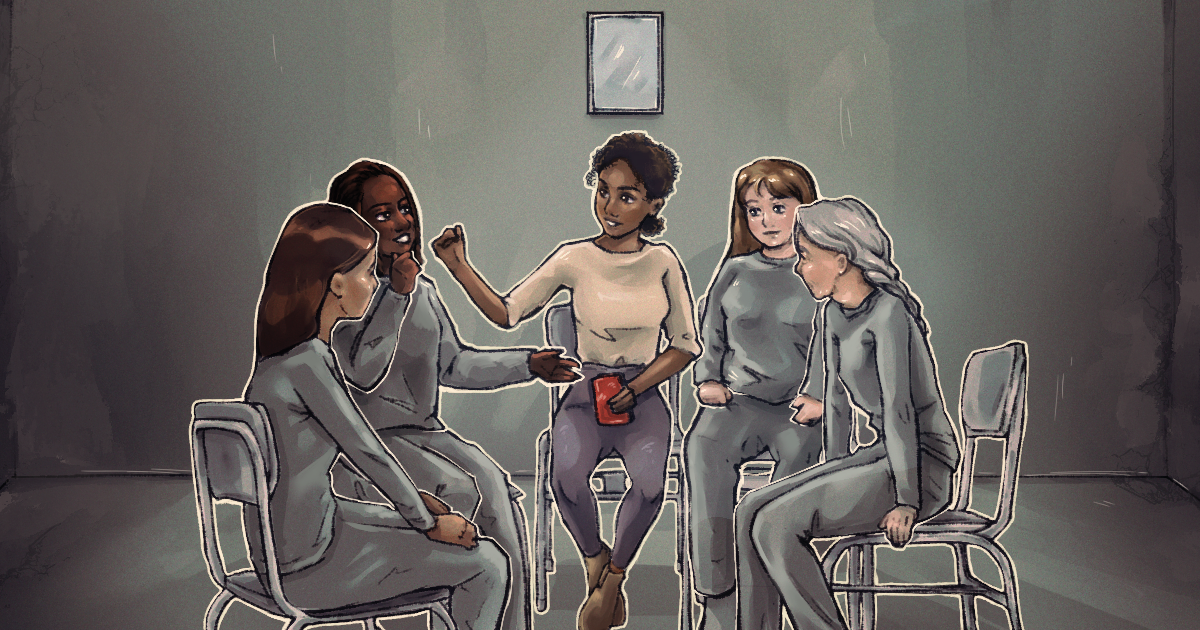
The outside professor and I collect and distribute the letters to avoid the DOC censors. These precautions help foster wide-ranging conversations about everything from life and death to kickboxing and cooking.
A few weeks into the semester the letters from our college exchange partners turn dark after a student dies in his dorm room from a drug overdose. The victim was friends with some of our outside letter writers.
An older woman here named Val who produces award winning poetry, talks about how painful it is to grieve for people who die young. She shares the story of an impromptu funeral for a beloved prison cat that served as an ersatz memorial service for all the women who died and disappeared over the years.
After reading the chapters narrated by a ghost in Jesmyn Ward’s Sing Unburied Sing, students swap stories about the supernatural. Believers and skeptics debate what’s plausible.
“I don’t believe in spirits spilling secrets,” writes Charice, a stately woman who manages to look dignified even in her shapeless prison smock. She is the one who tells the story about her father’s toupee.
“Some people,” she says, “would rather believe in ghosts than admit there are things we can’t explain.”
Ward’s book and the other texts for these classes are selected by the “outside” professor who is an expert on Shakespeare, Milton, 17th-Century poetry and pedagogy. She is also a long-time activist in the prison education movement.
After the DOC in her home state cancelled prison classes during the pandemic, she contacted the local nonprofit organization that sponsors prison exchange classes here.
Correctional officials are well aware that prison education provides a cost-effective way to reduce violence, boost morale among residents and staff, and up the odds that those who are released will not be rearrested. Despite this, DOC prioritizes “risk management” over rehabilitation.
That means hiring more officers instead of funding programs to treat, train or educate people in custody. Even though our organization, which is mainly staffed by volunteers, offers courses at no cost to the state, we act as though the prison is doing us a favor by giving us access to students and classrooms.
It goes without saying that the administrators could kick us out for any reason at any time.
I originally volunteer to fill in for a creative writing teacher who needs some time off. I lack the academic credentials of other teachers, who are college professors. My expertise is in economics and data presentation and I worked as a financial news reporter. But I’m not afraid to seek advice, and I enjoy learning alongside my students. It feels like an adventure.
When I’m later asked to “facilitate” the exchange class with the out-of-state Shakespeare professor, my first task is to review the syllabus and request permission to introduce the books.
The head of the nonprofit warns me that the DOC maintains a lengthy “Do-Not-Read” list. In fact, two of the texts for the second semester, a prison memoir and a course book on criminal justice, are among the black-listed titles.
I scramble to find alternatives, and to revise my discussion questions and writing assignments.
Even the approved books are a challenge to bring in. The entry protocol requires checking fingerprints, relinquishing my driver’s license, passing through a metal detector and submitting to a pat down. My phone stays in the car.
I’m asked to remove my shoes and hearing aids for inspection. My bag of books and photocopies are scanned. Then the books are unpacked and examined one by one. An officer pages through each copy separately. This process can take up to an hour.
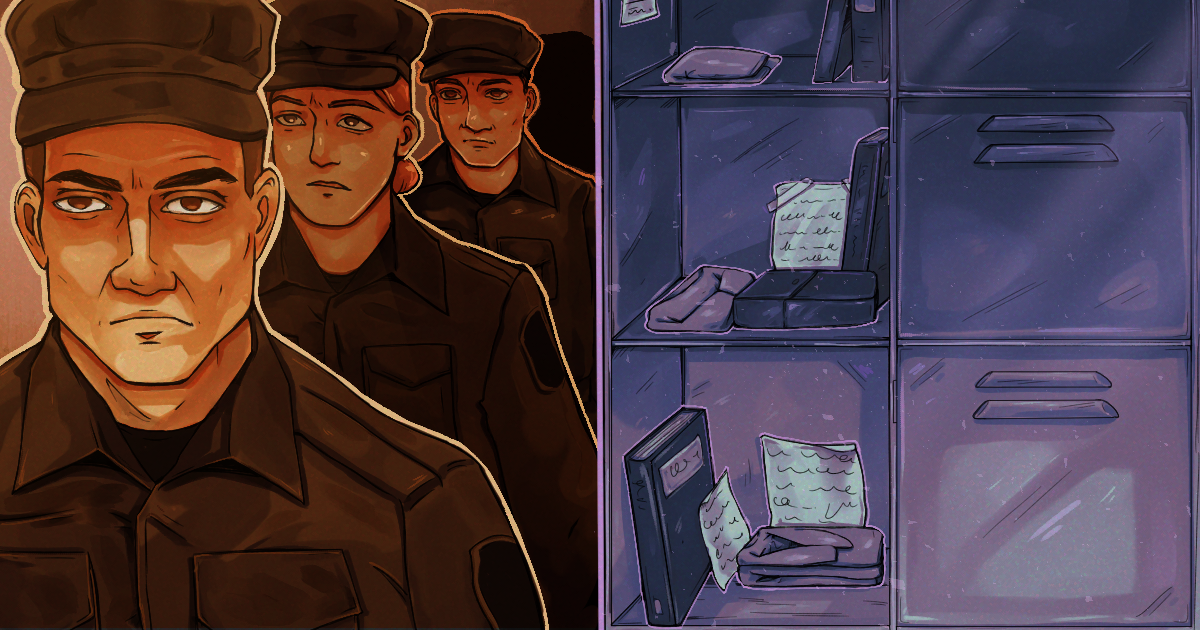
Prisons have long censored incoming books and personal letters. In the US these practices were codified by the US Supreme Court in 1989. The majority decision in Thornburgh v. Abbott gives federal and state governments broad discretion to override First Amendment freedoms for people in prison so long as the restrictions are reasonable and related to security concerns.
My students latch onto the word “reasonable.”
The stately Charice is upset about book bans on atlases, foreign language dictionaries, and popular fiction by James Patterson and John Grisham. “Those book censors quit being reasonable a long time ago,” she says.
“Pure paranoia,” is how Napoleon, author of the maple snow bowl story, describes the alleged threat posed by Dungeons and Dragons and the Game of Thrones series.
Napoleon is curious about everything from science fiction to psychology. She reports that D&D fans who challenged the ban were told the maps in those books might be used to plot an escape. Never mind that those maps depict the imaginary topography of a made-up world.
Sage, who is a talented artist and paints beautiful wall murals all over the campus, bemoans the loss of craft, puzzle, and coloring books, and origami instructions. Correction officials claim those books could be used as templates for tattoos.
The decisions of the state DOCs are usually final, with little or no chance to appeal. Some prohibited titles raise issues about race. Several states currently ban Michelle Alexander’s The New Jim Crow. A federal prison also pulled Barak Obama’s Dreams from my Father and The Audacity of Hope, allegedly due to concerns over national security.
Artist Sage also reports that the prison mail handlers have been busy confiscating recent issues of both Reader’s Digest and The Week magazine.
“They have to be flagging articles on police brutality,” she says. “What else could it be?”
The prohibited memoir on our syllabus is a New York Times bestseller entitled Writing My Wrongs by Shaka Senghor. The memoir tracks Senghor’s transformation from drug thug to an MIT Media Lab fellow.
During his 19 years in Michigan prisons, Senghor relied on reading, journaling, meditation, and kindness to help him come to terms with his crimes. When he was released from prison, he became an activist for reform.
“Why do you think that book got banned?” asks Charice.
“For starters,” says her outside partner, “he complained that prison corrupts the keepers as much or more than the kept.”
Charice replies: “I’ll bet they’d be ticked if we wrote a tell-all about the wigged-out officers around here.”
Napoleon jumps in to tell us about the Stanford Prison Experiment. In the 1970s a psychology professor recruited students to role play as prisoners and prison guards. The two-week simulation was shut down after six days because the guards became dangerously abusive. It was later critiqued for its questionable ethics. But it has also been widely cited to show how individuals can get carried away with their own authority.
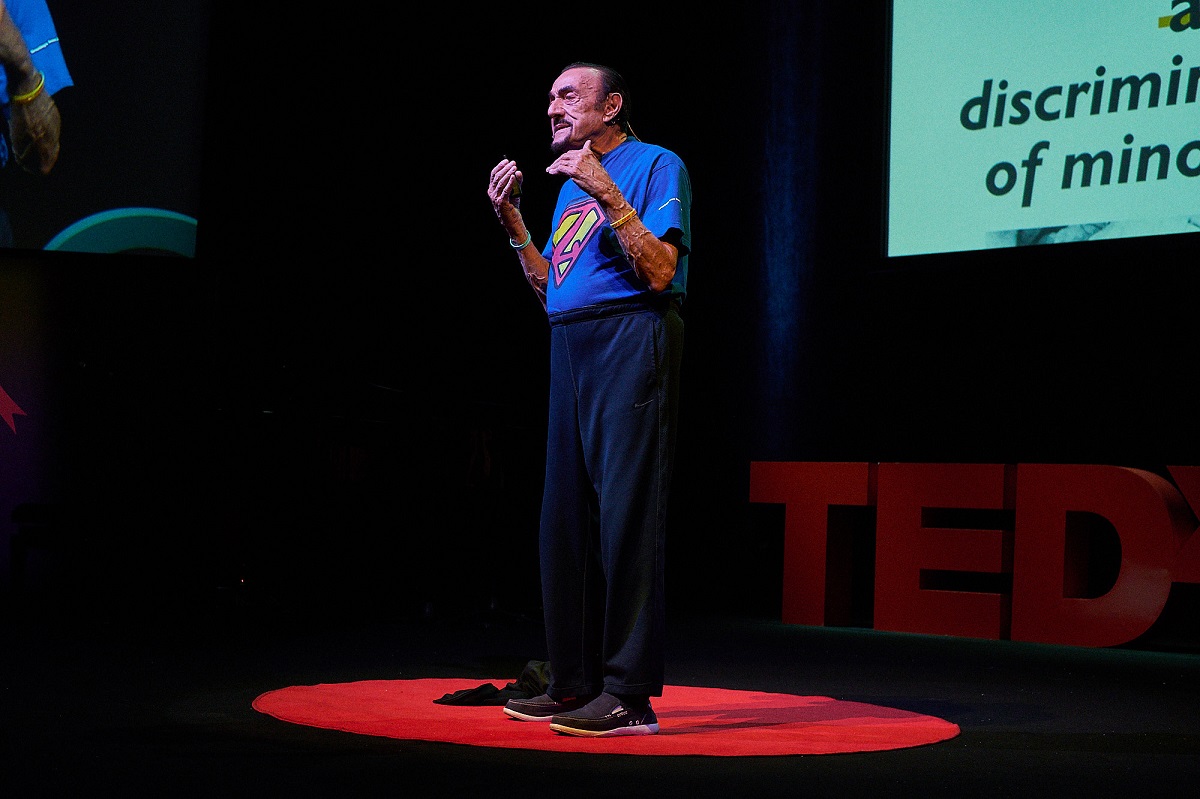
Psychologist Philip Zimbardo who conducted the Stanford Prison Experiment giving a Ted Talk. Picture by TedxRoma.
Poet Val, who works as a law clerk and files legal petitions for hearings and appeals, and grievances on behalf of other women, is tracking efforts to reverse state DOC bans on Prison Legal News. This monthly magazine, published by the Human Rights Defense Center, reviews US criminal cases, including decisions affecting prison conditions. It’s considered a vital resource for law clerks.
The bans on books and magazines are not the only policies that discourage people from reading or pursuing legal options.
The women are forced to limit all personal possessions, including books, documents, clothes and toiletries, to whatever fits inside a locker roughly the size of a medium dresser drawer
A twinkly-eyed woman who goes by “Jolly Roger” jokes about her minimalist lifestyle. “Who needs three pairs of pants when you have only one ass? Socks? That’s different. I keep two pairs because I have two feet. Same for bras.”
She pulls a sad face and says owning books is out of the question. “There’s never enough room.”
The locker limits are an especially bitter pill for anyone wanting to file a legal motion. The women used to store their legal records in the library. But a recent push to go paperless means that all mail, photos, and documents are supposed to be transferred to prison-issued tablets. The tablets break down frequently, and the contents are automatically erased after 30 days. This also means that the women’s own writings—their stories, class assignments and journals-cannot be kept beyond a month on their tablets, and hand written pages must compete for limited locker space.
The students return again and again in class discussions and in their letters to their court cases. Michelle Kuo’s Reading with Patrick, prompted conversations about overcharging and plea bargaining. It is common practice for US prosecutors to charge defendants with additional crimes and/or more serious crimes and then offer them reduced sentences to induce them to plead guilty. But the “reduced” sentences are often decades long, and in many states early release and parole are either abolished or rarely granted.
While I prefer not to know any more than my students care to divulge, I’m required to vet their letters for any disclosures that would compromise their privacy. It is often heart wrenching to learn a students’ history, and mind-bending to connect that history to an earnest and articulate woman who shows up for class and offers insights that command my respect. What strikes me over and over is the number of crimes that are driven by drugs.
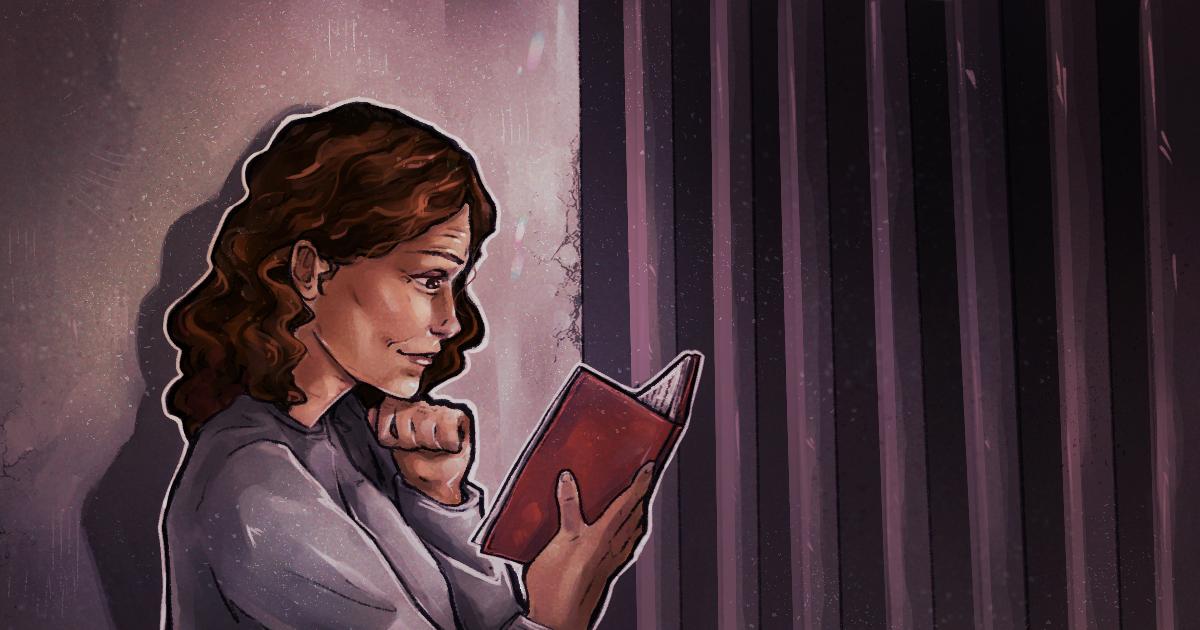
Artist Sage remembers being young and nerdy and wanting to protect a partner who eventually testified against her. She was charged as an accomplice in a case involving a drug deal that went sour.
A quiet 30-year-old student who always pulls her chair back from the circle writes, “I had everything going for me until I was injured in a car accident. My doctor prescribed oxycodone.”
When the prescription expired she sought illegal substitutes. She killed someone while driving under the influence. The charges were complicated by her erratic behavior during the arrest, and she now faces life in prison.
Another student confides that she rejected an eight-year plea deal and went to trial because she was innocent. But the jury didn’t believe her, and she also ended up with a life sentence. “Yes, I was an addict,” she writes. “That was a big part of it.”
A quiet blonde with scared eyes and muscle tics talks about losing her baby daughter to sudden infant death syndrome. She was 23 years old and fell into a depression. She started taking meth to numb out “just occasionally and then more and more.”
When the authorities investigated the baby’s death this woman and her husband tested positive for drugs. They are both serving time for child neglect and manslaughter.
Each story forces me to consider how many lives are wasted inside these walls.

The prison where I teach offers these women programs to help with drug and other addictions, classes in parenting and anger management, and re-entry skills for students scheduled for release.
While no one could call this a happy or healthy environment, my students appreciate that this facility is safer than most. The women here sew and launder uniforms for a nearby men’s prison. Poet Val, who worked in the laundry sorting clothes when she first arrived, reports that the men’s scrubs were delivered torn and bloody more often than you would imagine.
A week into our semester, Mattie, a middle-aged student with a sweet singsong voice, is shipped out to a larger prison, which is notoriously violent and chaotic. She requested a medical consultation, not realizing it would trigger a transfer.
Two months later, she is still waiting to see a doctor. Mattie writes to me that she is now asking to sign a “permanent refusal” of medical care in the hopes of getting transferred back again. Her options are limited to seeking medical treatment or returning to a less dangerous environment. The system will not allow her to do both.
I write back promising to have books and photocopies waiting for her when she returns.
As the semester unfolds, my original syllabus seems less and less relevant. I’m no longer interested in cramming our sessions with facts about mass incarceration. My students know enough about prisons already.
Instead, I want to show them how other prison writers framed those facts. I pull examples of documentary accounts, excerpts from authors like Patricia McConnel who wrote boldly about the sights, sounds and smells of prison. We read Danner Darcleight to learn how to turn prison settings into stories. We share Susan Burton’s fiery critiques of the system.
The one universal theme in every single memoir is the transformative power of reading and writing.
Yet in the background, I hear the constant din of DOC disapproval, pushing its own script, a story line that insists the way to turn bad people around is to break them, take away their books and their hopes, and silence their words.
I pack our class time with writing workshops and craft lectures.
I want to take my students’ stories, give them wings and send them soaring over the razor wire and the fences and out into the world. Those stories haunt me. I cannot ignore them.
I don’t know if it’s helping, but I keep showing up and so do my students. Thursdays at 3pm. I come armed with writings, ready to read, to discuss, and to listen, to give my students a space to mourn all that might have been, and to find words for what might yet be.
All artwork by Isabelle Broad.
Read more:
